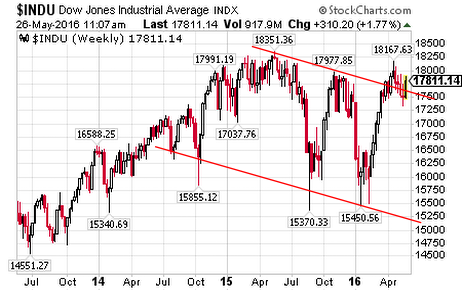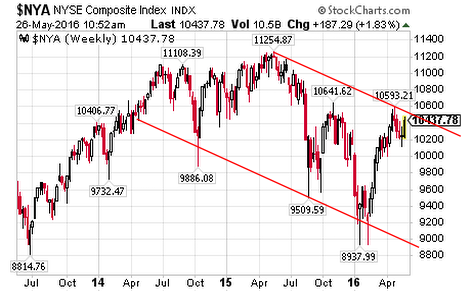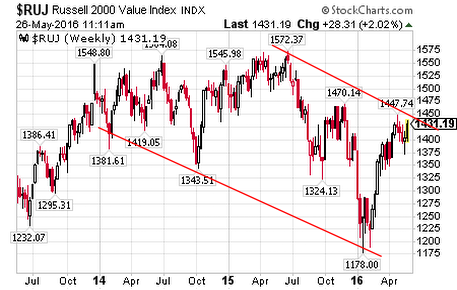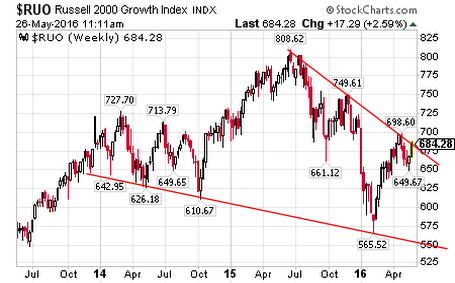4 Simple Charts that Make Me Worry About the Market
Plus, four steps you can take to protect your portfolio.

Whether you have an index fund, an actively managed portfolio or a tactical portfolio, for the past year or so, your portfolio probably has been doing so-so. Not performing poorly, but not doing great either. The portfolios of most investors aren’t crashing; they are sort of running in place.
But we have witnessed huge rallies in recent weeks. And also huge declines. So what’s going on?
To start with, the markets peaked about a year ago. Since then, investors have been on a volatile rollercoaster that has a downward bias.
From just $107.88 $24.99 for Kiplinger Personal Finance
Become a smarter, better informed investor. Subscribe from just $107.88 $24.99, plus get up to 4 Special Issues

Sign up for Kiplinger’s Free Newsletters
Profit and prosper with the best of expert advice on investing, taxes, retirement, personal finance and more - straight to your e-mail.
Profit and prosper with the best of expert advice - straight to your e-mail.
The Dow Jones industrial average peaked at 18,351 a year ago and has had two major declines since then. Each recovery rally has not been able to surpass the peak.

In technical terms, this is the resistance level through which the market needs to advance, or it will likely drop to a lower low than the January low.
But the Dow doesn’t really tell the whole story. Broader markets tell what is really going on.
The New York Stock Exchange also peaked about a year ago, and today it is about 7% off its high. Even after the rally from the January low, the NYSE is at about the same price that it was back in December 2013, almost two and a half years ago. So for two and a half years, the NYSE has basically gone nowhere.

It doesn’t stop there. The Russell 2000 Value index is down almost 9% from its high. Its recovery from the January low only puts it at the same level as October 2013. Again, another broad index that is showing lots of volatility has slowly declined from its peak a year ago and has given up gains for the past two and a half years.

Even the Russell 2000 Growth index is well off its high. It's down more than 15% from its high a year ago. And it has also given back two and a half years of action.

What we are likely seeing is a major top forming. Many of the broader markets are already in decline. Each chart shows lower lows and most show lower highs. This is indicative of a market in decline.
What could change? The Federal Reserve could always intervene. But this is the running out of gas part. How much can the Fed do with rates already near zero?
Some believe that the Fed could go to negative interest rates. What would this tell investors about the economy and markets? That things are so bad, the Fed had to resort to extreme measures?
Some say the Fed could start quantitative easing again by buying more bonds. They already own several trillion dollars' worth of Treasuries. What are they going to do? Buy them all?
Frankly, I wouldn't put it past them. They could do anything. However, the current group at the Fed and Treasury don’t hold a candle to the people that were in charge in 2008, and they couldn’t stop the market from falling apart.
So what is an investor to do? Here are four steps:
1. Clean Up Your Portfolio
Do what Warren Buffett says, and only own the things you would be happy to hold if they closed the market for five or 10 years.
2. Raise Cash
There will likely be some buys when the bear market finally gets going. There are plenty of good solid companies that pay a 3% to 4% dividend today that I would rather buy tomorrow when they yield 6% to 7%. It's hard to buy if you don't have cash.
3. Understand Your Strategy
If you have a tactical strategy, it is not designed to get you out at the top and in at the bottom. It is not designed to play every short-term drop and rally. It is designed to look for major turning points.
If you have a buy and hold strategy, be prepared to hold onto a lot of securities that are dropping in value—a lot. I do not recommend a buy and hold strategy in this environment. (For another view on buy and hold, see Keep Your Investing Simple.)
4. Get a Professional Review
See if your portfolio matches your risk tolerance, your long-term growth objectives, how balanced it is, if its asset allocation is appropriate for the environment and most of all, if there are any highly overvalued securities in your portfolio. Your favorite stock may be a great company, but if the stock is trading well above its fair value, it could quickly become your least favorite stock.
John Riley, registered Research Analyst and the Chief Investment Strategist at CIS, has been defending his clients from the surprises Wall Street misses since 1999.
Disclosure: Third party posts do not reflect the views of Cantella & Co Inc. or Cornerstone Investment Services, LLC. Any links to third party sites are believed to be reliable but have not been independently reviewed by Cantella & Co. Inc or Cornerstone Investment Services, LLC. Securities offered through Cantella & Co., Inc., Member FINRA/SIPC. Advisory Services offered through Cornerstone Investment Services, LLC's RIA. Please refer to my website for states in which I am registered.
Profit and prosper with the best of Kiplinger's advice on investing, taxes, retirement, personal finance and much more. Delivered daily. Enter your email in the box and click Sign Me Up.

In 1999, John Riley established Cornerstone Investment Services to offer investors an alternative to Wall Street. He is unique among financial advisers for having passed the Series 86 and 87 exams to become a registered Research Analyst. Since breaking free of the crowd, John has been able to manage clients' money in a way that prepares them for the trends he sees in the markets and the surprises Wall Street misses.
-
 Samsung Galaxy S25 Ultra for $4.99 a Month: A Closer Look at Verizon’s Deal
Samsung Galaxy S25 Ultra for $4.99 a Month: A Closer Look at Verizon’s DealVerizon’s aggressive pricing makes Samsung’s top-tier phone tempting, but the real cost depends on your plan and how long you stay.
-
 I'm 59 with $1.7 million saved and lost my job. Should I retire?
I'm 59 with $1.7 million saved and lost my job. Should I retire?We asked professional wealth planners for advice.
-
 4 Times to Say Yes to a Roth Conversion and 4 Times to Say No
4 Times to Say Yes to a Roth Conversion and 4 Times to Say NoRoth conversions should never be done on a whim — they're a product of careful timing and long-term tax considerations. So how can you tell whether to go ahead?
-
 A Wealth Adviser Explains: 4 Times I'd Give the Green Light for a Roth Conversion (and 4 Times I'd Say It's a No-Go)
A Wealth Adviser Explains: 4 Times I'd Give the Green Light for a Roth Conversion (and 4 Times I'd Say It's a No-Go)Roth conversions should never be done on a whim — they're a product of careful timing and long-term tax considerations. So how can you tell whether to go ahead?
-
 A 4-Step Anxiety-Reducing Retirement Road Map, From a Financial Adviser
A 4-Step Anxiety-Reducing Retirement Road Map, From a Financial AdviserThis helpful process covers everything from assessing your current finances and risks to implementing and managing your personalized retirement income plan.
-
 The $183,000 RMD Shock: Why Roth Conversions in Your 70s Can Be Risky
The $183,000 RMD Shock: Why Roth Conversions in Your 70s Can Be RiskyConverting retirement funds to a Roth is a smart strategy for many, but the older you are, the less time you have to recover the tax bite from the conversion.
-
 A Financial Pro Breaks Retirement Planning Into 5 Manageable Pieces
A Financial Pro Breaks Retirement Planning Into 5 Manageable PiecesThis retirement plan focuses on five key areas — income generation, tax management, asset withdrawals, planning for big expenses and health care, and legacy.
-
 4 Financial To-Dos to Finish 2025 Strong and Start 2026 on Solid Ground
4 Financial To-Dos to Finish 2025 Strong and Start 2026 on Solid GroundDon't overlook these important year-end check-ins. Missed opportunities and avoidable mistakes could end up costing you if you're not paying attention.
-
 Are You Putting Yourself Last? The Cost Could Be Your Retirement Security
Are You Putting Yourself Last? The Cost Could Be Your Retirement SecurityIf you're part of the sandwich generation, it's critical that you don't let the needs of your aging parents come at the expense of your future.
-
 I'm an Insurance Pro: It's Time to Prepare for Natural Disasters Like They Could Happen to You
I'm an Insurance Pro: It's Time to Prepare for Natural Disasters Like They Could Happen to YouYou can no longer have the mindset that "that won't happen here." Because it absolutely could. As we head into 2026, consider making a disaster plan.
-
 The Future of Philanthropy Is Female: How Women Will Lead a New Era in Charitable Giving
The Future of Philanthropy Is Female: How Women Will Lead a New Era in Charitable GivingWomen will soon be in charge of trillions in charitable capital, through divorce, inheritance and their own investments. Here's how to use your share for good.